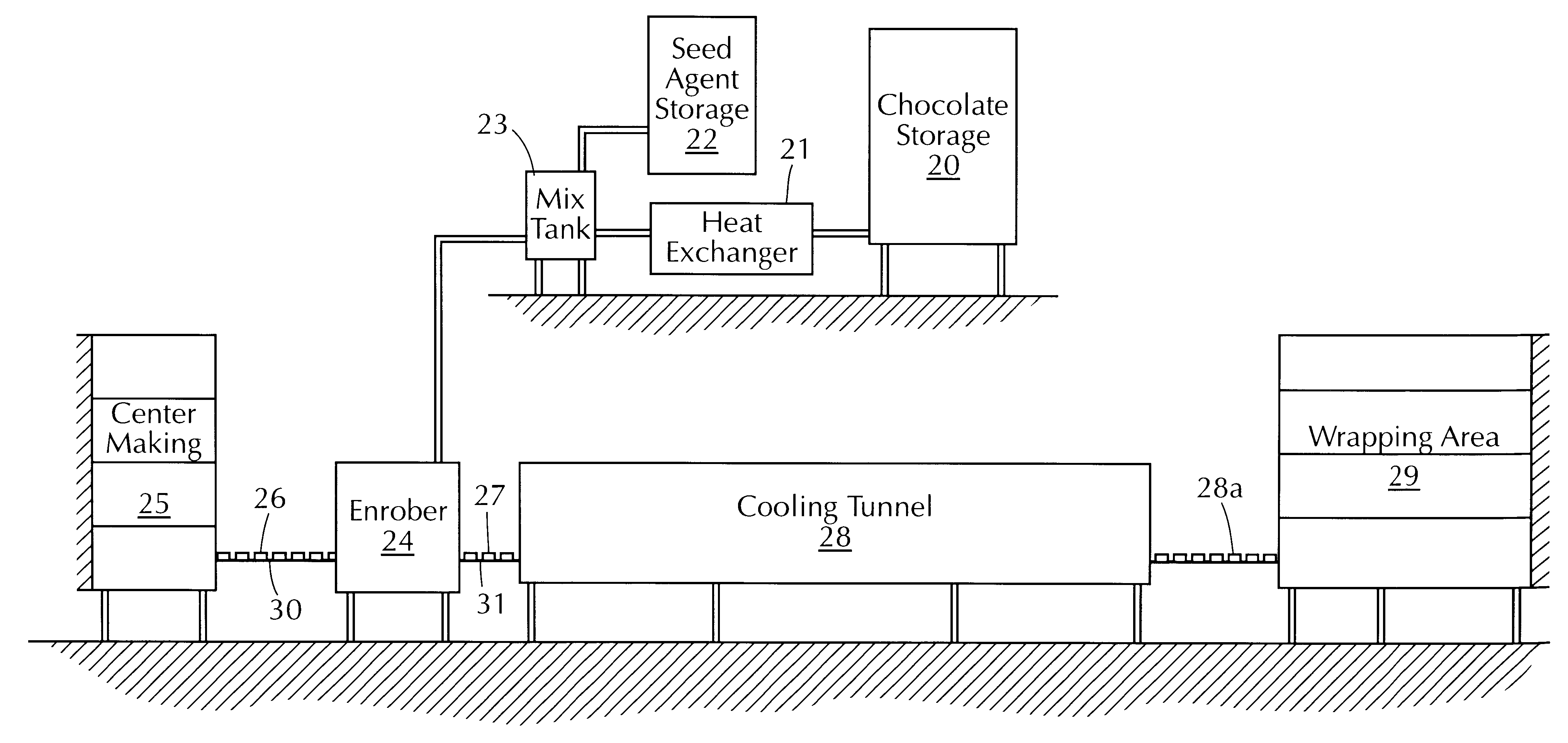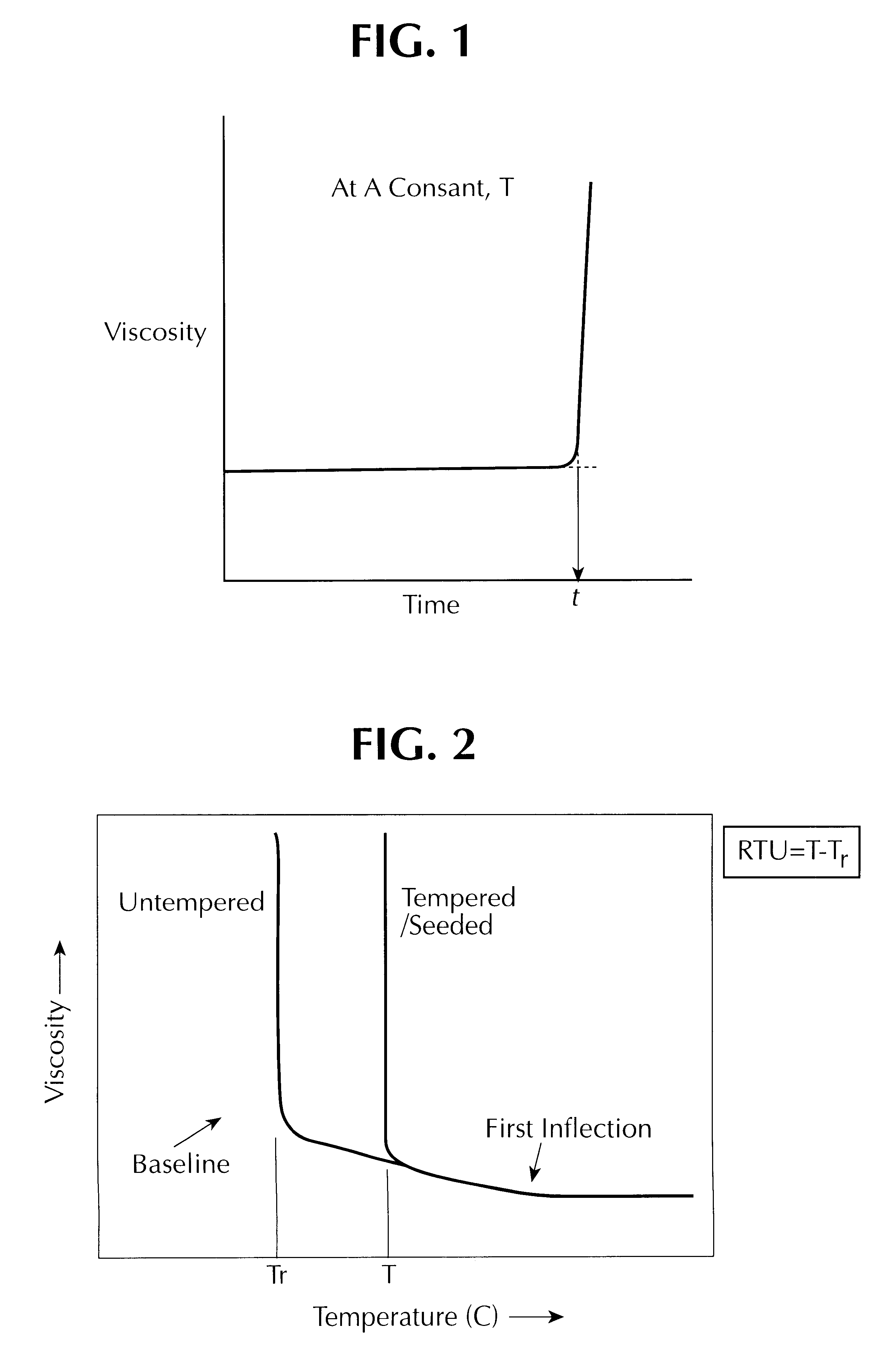Methods of processing chocolates at low viscosities and/or at elevated temperatures using seeding agents and products produced by same
- Summary
- Abstract
- Description
- Claims
- Application Information
AI Technical Summary
Benefits of technology
Problems solved by technology
Method used
Image
Examples
example 1
A milk chocolate composition is prepared using the formulation in Table 1-A below:
The chocolate mixture is refined to reduce the solid particle sizes to 25 microns (by micrometer) and then loaded into a Petzholdt Conge. The chocolate is dry conged for 6 hours after which lecithin is added. The chocolate is then spun in the conge for 30 minutes. The conged chocolate is transferred into a tank where additional lecithin and cocoa butter are added (standardization) to achieve an apparent viscosity of 20,000 cPs at 45.degree. C. The apparent viscosity is measured by the use of a Brookfield HA type viscometer with TB spindle at 4 RPM. The standardized chocolate is then tempered in a continuous Sollich Solltemper-Turbo Model MSV3000 where the chocolate is cooled from 45.degree. C. to 28.degree. C. with aggressive shear to produce cocoa butter crystals of stable and unstable polymorphs. The tempered chocolate is warmed slightly in the last section of the Solltemper to 31.degree. C. to melt ...
example 2
A milk chocolate having a formulation similar to that used in Example 1 is prepared in the manner described in Example 1. The chocolate is cooled in an APV Votator scraped surface heat exchanger from the 45.degree. C. storage temperature to the seed agent addition temperature of 33.5.degree. C. The temperature of the chocolate is maintained at the seed agent addition temperature until enrobing on the centers. Cocoa butter seed agent (CBSA) as prepared from solidified cocoa butter by the cryo-milling method set forth in Hachiya et al., Seeding Effects and Solidification Behavior of Cocoa Butter and Dark Chocolate, 1. Kinetics of Solidification, JAOCS, Vol. 66, (no.12) 1989, has a peak melting point of 35.6.degree. C., average particle size of 5-10 microns (optically measured) and is comprised of 42% Form VI cocoa butter polymorph. The CBSA is added to the chocolate at a 0.8% (by weight) addition rate and well mixed continuously, i.e., the rate of addition of seeding agent is such tha...
example 3
Chocolate is prepared as set forth in Example 1. CBSA is prepared as set forth in Example 2 and has a peak melt point of 35.7.degree. C., is comprised of 37% Form VI Cocoa butter polymorph, and has a particle size of 5-10 micron. The chocolate is cooled to 33.2.degree. C. in a manner similar to Example 2 and is added batch-wise to one of two 10,000 kg capacity, temperature controlled (33.2.degree. C.), agitated tanks. The CBSA is added simultaneously to the tank. The tank contains 9,900 kg of cooled chocolate and 100 kg of CBSA when filled. Upon filling the first tank, the flow of chocolate and CBSA changes to the second tank. This cycle continues alternating tanks so that the feed of CBSA and chocolate is maintained in a continuous fashion. This method of blending is commonly known as "batch-continuous". The use rate of seeded chocolate is approximately 2000 kg / h, therefore the average hold time in each tank is 2.5 hours with total use time of 5 hours. The seeded chocolate maintain...
PUM
 Login to View More
Login to View More Abstract
Description
Claims
Application Information
 Login to View More
Login to View More - Generate Ideas
- Intellectual Property
- Life Sciences
- Materials
- Tech Scout
- Unparalleled Data Quality
- Higher Quality Content
- 60% Fewer Hallucinations
Browse by: Latest US Patents, China's latest patents, Technical Efficacy Thesaurus, Application Domain, Technology Topic, Popular Technical Reports.
© 2025 PatSnap. All rights reserved.Legal|Privacy policy|Modern Slavery Act Transparency Statement|Sitemap|About US| Contact US: help@patsnap.com



